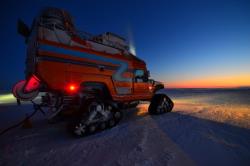
The ZERO SOUTH team converted a pair of Hummer H1s to hybrid vehicles for South Pole expeditions | If you think about hybrid vehicles, the prime example that comes to most people’s minds is the venerable Toyota Prius – and for good reason. They have been around for over 20 years and are a popular option for people looking to lessen their carbon footprint. On the other end of the spectrum is arguably one of the least ‘green’ vehicles around – the Hummer H1.Based off the M998 HMMWV, or Humvee, by AM General, the Hummer H1 is a civilian off-road vehicle powered by one of four diesel engines or a 5.7L gas engine. The H1 weighs anywhere from 7,847 to 8,117 lbs and gets 8-12 MPG on a good day. So why would an organization that is planning to travel to the South Pole using no fossil fuels, pick an H1 Hummer as their expedition vehicle? 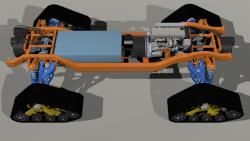
This CAD drawing shows they layout of the chassis without the body | It comes down to two words: irony and utility.Drive Around the World is an organization that was founded over 15 years ago to help promote cross-border understanding and goodwill through innovative educational programs, as well as raise funds and awareness for charitable causes. One of their upcoming expeditions is called ZERO SOUTH. This will be a journey across Antarctica using zero fossil fuels. Instead, they will use batteries and biofuel on their expedition from the coast of Antarctica to the South Pole. 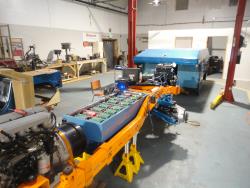
To start with a clean slate, the team tore both vehicles down to nuts and bolts and rebuilt them | “The choice of vehicle is ironic. However, initial testing indicates a symbol of military defense used for environmental defense is popular with most audiences and resonates considerably with young people,” said Nick Baggarly, Executive Director at Drive Around the World. “People are polarized by these vehicles – they either love them or hate them. However, their use in extreme environments and as platforms to demonstrate new technology has precedent and is appealing to both groups.”Even more ironic is the fact that the expedition includes scientists who will perform climate science out of the back of the Hummer. Beyond the irony, these vehicles provide a wide footprint with modular construction that makes it almost the perfect vehicle for conversion to electric drive. It is also very capable off-road, and with the modifications the team made to the base vehicle, it is just about indestructible. 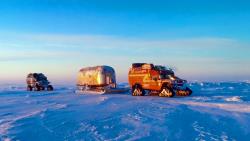
During one of their test runs in Alaska, the ZERO SOUTH team but the both PTVs through their paces | The vehicle build team at Drive Around the World picked up a pair of H1 Hummers, or Polar Traverse Vehicles (PTV) as they call them, that would serve as expeditionary rigs and tow vehicles for their equipment. The first one, PTV-1, was based off a 1998 civilian Hummer H1, the second, PTV-2, started life as a 1996 Civilian H1. The vehicles would be identical in every way, except for the color. With the vehicles obtained, it was time to get to work rebuilding them to be hybrid vehicles capable of handling everything the unforgiving continent of Antarctica could throw at them. 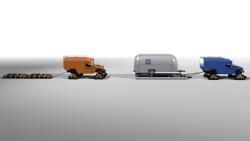
As you can see in this CAD illustration, one PTV will tow the trailer, the other will tow supplies | These PTVs would have to endure some of the most inhospitable terrain and environment on Earth. The ZERO SOUTH team could not risk breaking down because of a faulty bolt or worn through wire harness. To ensure that every part on each vehicle was ready for the expeditions ahead, the build team tore both vehicles down to nuts and bolts. This gave the team a clean slate to build on. Between the frame rails, a five-foot box was built to house dual battery packs. The batteries would be used to drive a pair of 150kW UQM electric traction motors that were then connected to the factory Hummer driveline by K&N Engineering. K&N may be an odd choice for electric vehicle conversion, but Nick has an explanation for that. “When I first asked K&N Engineering to get behind this project, I knew they had disrupted the automotive air filter market with a lifetime, reusable air-filter that keeps disposable filters out of landfills. K&N makes the world's best product to clean the air that goes into your car's engine, and their support for ZERO SOUTH demonstrates they care about the air we breathe as well.” 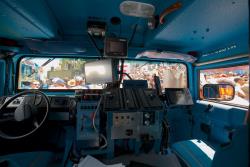
The cab resembles that of a space shuttle instead of a 20 year old military vehicle | The stock driveline was retained. However, since the vehicle would be fitted with tracks, which can be tough on components, the axles, differentials, hubs, and steering components were upgraded to units from a 12,100 GVW (armored) military HMMWV. Also, during the conversion, the K&N team noticed something interesting. They remarked on how the H1 chassis is remarkably symmetrical and decided to flip the front and rear differentials so the pinions would face outboard. This clever packaging change allowed the electric motors to be mounted outboard with one immediately behind the front bumper and the other directly behind the rear bumper. This bought them room in the engine compartment for a larger generator and significantly more room between the frame rails for the largest battery box possible. The pervasive thinking meant more batteries and more all-electric range. 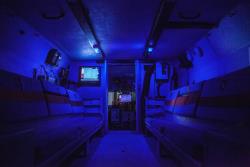
Most of the scientific work will go on in the back of the PTVs. The ambulance hardtops lots of room. | With the electric side completed, the team installed a Steyr 6-cylinder turbodiesel engine connected to a 150kW UQM motor that would be used as a generator/range extender. It runs on a renewable aviation biofuel called Synthetic Paraffin Kerosene. It is made of a blend of inedible oils that has been converted to an EPA-approved fuel. Finally, the hybrid drivetrain was completed and the team could turn their attention to the rest of the vehicle.To give the team an area to work inside the Hummer, a pair of ambulance hardtops from military HMMWVs were installed on the two PTVs. This provided enough room for the teams to stand up and walk around. The necessary equipment and tools needed for the expedition would be housed in the back of the Hummers, on the roof racks, in the accompanying Airstream trailer, or on a ski rig that would be towed behind one of the PTVs. One of the features that is most noticeable of the PTVs is the tracks on the four corners. These are manufactured by Mattracks and make traversing the ice shelves of Antarctica a lot easier by spreading out the 11,320 lbs of each PTV over a greater surface area. Behind the tires or tracks, whichever setup they are running with, is a set of Baer brakes that provide enough clamping force to bring the whole rig to a quick halt if need be. 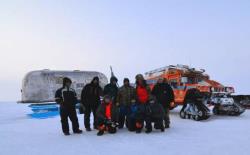
Here the ZERO SOUTH team celebrates a successful test excursion of the PTVs in Alaska | With the trucks built, they went to paint. PTV-1 received several coats of orange on the frame, while the body was covered in a metallic blue. PTV-2 received the opposite, with a blue frame and an orange body. Both trucks then received a saturated metal flake graphic on the sides. On the right is a ‘Z’ and on the left is an ‘S’ to signify ZERO SOUTH. “I dreamed up this project like a ten-year old, so I thought the vehicle should look like those terrycloth surfer shirts we used to wear when we were ten,” explained Nick.With the paint schemes and the tracks, these vehicles are instantly recognizable and Nick and his crew know this. They use the vehicles to help promote environmental responsibility at events around the globe. Most recently, they attended a rally for science in Los Angeles. Their next expedition, which will be another test excursion, will be in November of 2017, so keep an eye out for more articles on Drive Around the World and their iconic H1 Polar Traverse Vehicles. |


















